Related Research Articles

The Arabian Desert is a vast desert wilderness in West Asia that occupies almost the entire Arabian Peninsula with an area of 2,330,000 square kilometers (900,000 sq mi). It stretches from Yemen to the Persian Gulf and Oman to Jordan and Iraq. It is the fifth largest desert in the world and the largest in Asia. At its center is Ar-Rub' al-Khali, one of the largest continuous bodies of sand in the world. It is an extension of the Sahara Desert.
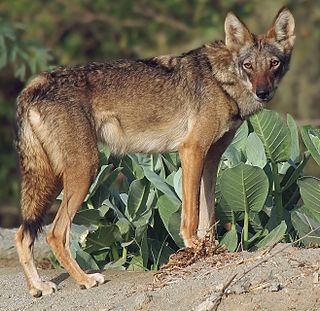
The Arabian wolf is a subspecies of gray wolf native to the Arabian Peninsula—to the west of Bahrain, as well as Oman, southern Saudi Arabia, and Yemen. They are also found in Israel’s Negev and Arava Deserts, Jordan, Palestine, and Egypt's Sinai Peninsula. It is the smallest Gray wolf subspecies, and a specialized xerocole (arid-adapted) animal that normally lives in smaller familial packs. Arabian wolves are omnivorous and opportunistic eaters; they consume small to medium-sized prey, from insects, reptiles and birds to rodents and small ungulates, such as young Nubian ibex and several species of gazelle.
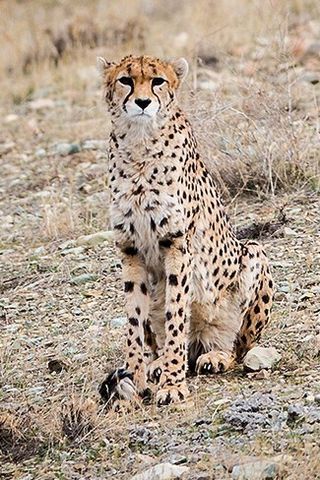
The Asiatic cheetah is a critically endangered cheetah subspecies currently only surviving in Iran. Its range once spread from the Arabian Peninsula and the Near East to the Caspian region, Transcaucasus, Kyzylkum Desert and northern South Asia, but was extirpated in these regions during the 20th century. The Asiatic cheetah diverged from the cheetah population in Africa between 32,000 and 67,000 years ago.

The Eastern Mediterranean conifer-sclerophyllous-forests, also known as the Eastern Mediterranean conifer-forests, is an ecoregion in the eastern Mediterranean Basin. It covers portions of Turkey, Syria, Iraq, Lebanon, Israel, Palestinian territories, Jordan, and Saudi Arabia.

The Yotvata Hai-Bar Nature Reserve is a 3,000-acre (12 km2) breeding and reacclimation center administered by the Israel Nature Reserves & National Parks Authority, situated in the Southern Arava near Yotvata.
The wildlife of Iran include the fauna and flora of Iran.

The wildlife of Azerbaijan consists of its flora and fauna and their natural habitats.

The Tibesti-Jebel Uweinat montane xeric woodlands is a deserts and xeric shrublands ecoregion in the eastern Sahara. The woodlands ecoregion occupies two separate highland regions, covering portions of northern Chad, southwestern Egypt, southern Libya, and northwestern Sudan.
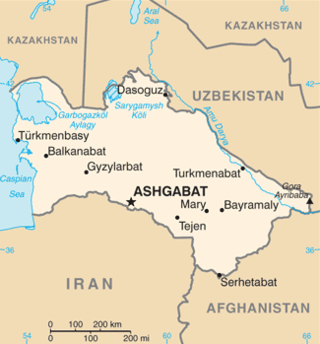
The Badhyz State Nature Reserve is a protected area (zapovednik) in south-western Turkmenistan that was established in 1941 and extends over 877 km2 (339 sq mi) in the Mary and Akhal Provinces. It is located south of the Karakum Desert, and the Tejen River forms its western border.

Narayan Sarovar Sanctuary also popularly known as Narayan Sarovar Wildlife Sanctuary or Narayan Sarovar Chinkara Sanctuary notified as such in April 1981 and subsequently denotified in 1995 with reduced area, is a unique eco-system near Narayan Sarovar in the Lakhpat taluka of Kutch district in the state of Gujarat, India. The desert forest in this sanctuary is said to be the only one of its kind in India. Located in the arid zone, a part of it is a seasonal wetland. It has 15 threatened wildlife species and has desert vegetation comprising thorn and scrub forests. Its biodiversity has some rare animals and birds, and rare flowering plants. Wildlife Institute of India (WII) has identified it as one of the last remaining habitats of the cheetah in India and a possible reintroduction site for the species. The most sighted animal here is the chinkara, which is currently the flagship species of the sanctuary.
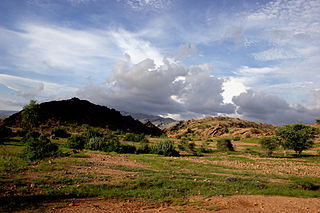
The Kirthar National Park is situated in the Kirthar Mountains in Jamshoro District in Sindh, Pakistan. It was established in 1974 and encompasses over 3,087 km2 (1,192 sq mi), making it the third largest national park in Pakistan. Wildlife in the park comprises leopard, striped hyena, Indian wolves, honey badger, urial, chinkara gazelles and rare Sindh ibex. Blackbuck are kept in enclosures for a reintroduction project.
Nayband Wildlife Sanctuary, Naybandan Wildlife Refuge or Nayband National Park is a National Park in Iran. It is situated in South Khorasan Province at 180.0 km (111.8 mi) south of Tabas. It has recently been given legal protection.
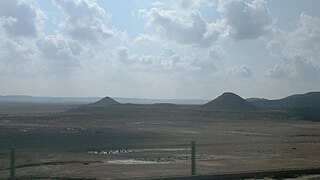
The Mesopotamian shrub desert is a deserts and xeric shrublands ecoregion in Western Asia. It extends across portions of Israel, Jordan, Syria, Iraq, and Iran.
References
- 1 2 3 Mohammad S. Farhadinia, Bahman Shams Esfandabad, Mahmoud Karami, Fatemeh Hosseini-Zavarei, Hossein Absalan and Bagher Nezami: Goitered Gazelle Gazella subgutturosa Guldenstaedt, 1780: its habitat preference and conservation needs in Miandasht Wildlife Refuge, northeastern Iran. Zoology in the Middle East 46, 2009. PDF
- ↑ Female Asiatic Cheetah, cub sighted in Miandasht
- ↑ "Asiatic Cheetah spotted in NE Iran". 28 June 2015. Retrieved 3 July 2015.